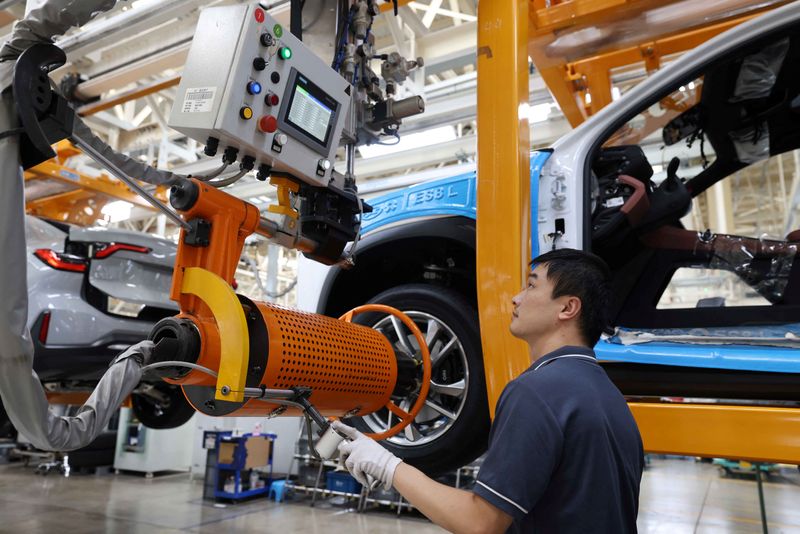By Liangping Gao and Ryan Woo
BEIJING (Reuters) - China's factory activity shrank faster than expected in May on weakening demand, heaping pressure on policymakers to shore up a patchy economic recovery and knocking Asian financial markets lower.
The official manufacturing purchasing managers' index (PMI) fell to a five-month low of 48.8, the National Bureau of Statistics (NBS) said on Wednesday, down from 49.2 in April and below the 50-point mark that separates expansion from contraction. The PMI also dashed forecasts for an increase to 49.4.
Service sector activity expanded at the slowest pace in four months in May, with the official non-manufacturing PMI falling to 54.5 from 56.4.
The readings pushed markets in Asia into the red with the yuan and Australian and New Zealand dollars tumbling and regional stocks falling sharply.
"The PMI data reveal that China may heading to a K-shaped recovery," said Bruce Pang, chief economist at Jones Lang LaSalle.
"The sluggish domestic demand could weigh on China's sustainable growth, if there are no efficient and effective policy moves to engineer a broad-based recovery," said Pang.
The PMIs also echoed weak factory data from other parts of Asia with Japan reporting a surprise decline in output and South Korean production weakening.
The world's second-largest economy is emerging from three years of pandemic lockdowns, but the recovery has been uneven with services spending outperforming activity in the factory, property and export-oriented sectors.
The PMI subindexes for May showed factory output swung to contraction from an expansion while new orders, including new exports, fell for the second month.
Chemical, ferrous metal smelting and rolling processing industries faced significant declines in production and demand, said NBS.
In the services sector, rail and air transport, accommodation and catering sectors remained in the expansion, on the back of strong May Labor Day travel, while real estate activity fell.
LOSING MOMENTUM
The PMIs and other economic indicators for April add to evidence that the rebound is losing steam.
Last month, imports contracted sharply, factory gate prices fell, property investment slumped, industrial profits plunged and factory output and retail sales both missed forecasts.
Analysts are now downgrading their expectations for the economy with Nomura and Barclays (LON:BARC) both cutting China's 2023 GDP growth forecasts.
"Proactive fiscal policies, rate cuts or RRR cuts and targeted monetary policy tools together with structural reform would be key," Jones Lang LaSalle's Pang added.
To spur credit growth, the central bank in March cut banks' reserve requirement ratios.
Premier Li Qiang said this month more targeted measures were needed to boost demand while China's central bank said on May 15 it would provide "strong and stable" support for the real economy.

Amid the weakness, China's post-pandemic stock rally is faltering as small-time investors turn bearish on equities to double down instead on safer assets.
"The sentiment in the financial market is quite bearish. It is not clear how the government interpret the current economic condition," said Zhiwei Zhang, chief economist at Pinpoint Asset Management. "There is no sign of imminent policy response. The government may continue to take a 'wait and see' stance for now."